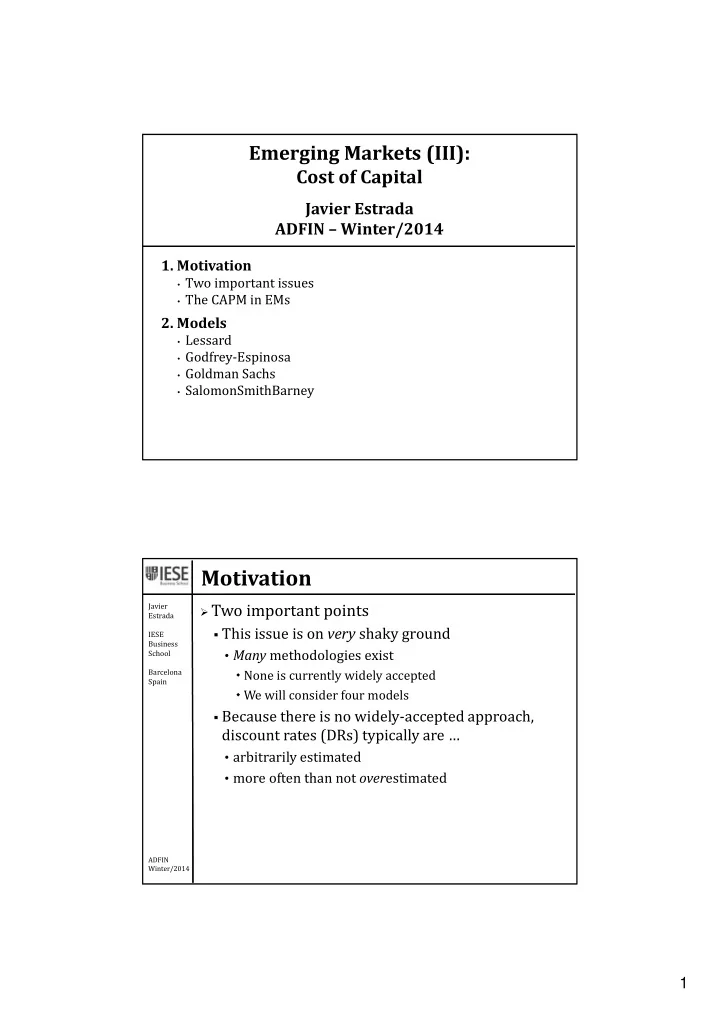

Emerging Markets (III): Cost of Capital Javier Estrada ADFIN – Winter/2014 1. Motivation • Two important issues • The CAPM in EMs 2. Models • Lessard • Godfrey‐Espinosa • Goldman Sachs • SalomonSmithBarney Motivation Two important points Javier Estrada This issue is on very shaky ground IESE Business • Many methodologies exist School Barcelona None is currently widely accepted Spain We will consider four models Because there is no widely‐accepted approach, discount rates (DRs) typically are … • arbitrarily estimated • more often than not over estimated ADFIN Winter/2014 1
The CAPM in EMs Theoretical problems Javier Estrada The ‘arbitrage’ assumption within/across EMs IESE Business (EMs are ‘less efficient’ than DMs) School Practical problems Barcelona Spain ‘Low’ correlation between mean returns and betas • Rho (MR‐Beta, 1988‐2013) = 0.48 • Rho (MR‐SD, 1988‐2013) = 0.61 • Rho (MR‐SSD, 1988‐2013) = 0.56 ‘Low’ estimates of the required return on equity • RR (Colombia) = 6.8% • RR (Malaysia) = 7.2% • RR (Egypt) = 7.5% • RR (EMs) = 8.8% ADFIN Winter/2014 To Keep in Mind Throughout Direct and indirect investments in EMs should be Javier Estrada broadly diversified IESE Business Q : How correlated are the political (and other) risks School in the countries in which your company invests? Barcelona Spain Avoid an arbitrary estimation of DRs Q : Can you defend/justify the DR you use? Q : Aren’t you too conservative in the DR you use (hence bypassing valuable opportunities)? Q : Have you considered what your DR implies in terms of cash flows scenarios? ADFIN Winter/2014 2
Models For all models keep in mind the following Javier Estrada Evaluations are typically made in strong currency IESE Business • CFs are first estimated in local currency and then School converted to strong currency Barcelona Spain • Discount rates should be estimated in the same strong currency • Given a dollar ‐based valuation and a global approach Dollar‐based risk‐free rate (10‐year US Treasury yield) Dollar‐based world market risk premium (5–6%) Given a global approach, betas are estimated with respect to the world market • Country betas and industry/sector betas Political risk is approximated with the yield spread • Political risk = YS c ADFIN Winter/2014 Models Lessard Javier Estrada Replace beta by ‘offshore beta’ IESE Business School • Project beta ( β p ) with respect to the world market Barcelona Spain Beta of the project’s industry/sector (MSCI, S&P, …) • Country beta ( β c ) with respect to the world market Beta of the country on which the project is based • Offshore beta β p · β c Model • R = R f + MRP ⋅ ( β p · β c ) ADFIN Winter/2014 3
Models Godfrey ‐ Espinosa Javier Estrada Adjust the risk‐free rate by the yield spread ( YS c ) IESE Business School • R f + YS c Barcelona Spain Replace beta by the ratio of standard deviations • σ c / σ w Adjust for double counting of risk • (0.6)·( σ c / σ w ) Model • R = ( R f + YS c ) + MRP ⋅ {(0.6) ⋅ ( σ c / σ w )} ADFIN Winter/2014 Models Goldman Sachs Javier Estrada Very similar to the Godfrey‐Espinosa model IESE Business School Better double‐counting adjustment Barcelona Spain • Eliminate fixed adjustment (0.6) • Replace by dynamic adjustment (1– ρ SB ) • This yields an adjusted beta → (1– ρ SB )·( σ c / σ w ) If ρ SB = 1 ⇒ Adjusted beta = 0 If ρ SB = 0 ⇒ Adjusted beta = σ c / σ w Model Go • R = ( R f + YS c ) + MRP ⋅ {(1– ρ SB ) ⋅ ( σ c / σ w )} ADFIN Winter/2014 4
Models SalomonSmithBarney Javier Estrada Distinctive features IESE Business School • Global CAPM Barcelona Spain Global market risk premium Global beta • Unadjusted political risk premium Yield spread • Subsequent adjustment Subjective/ad‐hoc • Unlike the other models, it yields a subjective DR ADFIN Winter/2014 Models SalomonSmithBarney (Cont.) Javier Estrada Adjusted political risk premium IESE Business • γ 1 → Access to capital markets School Barcelona 0–10, with 0 indicating best access Spain • γ 2 → Susceptibility of investment to political risk 0–10, with 0 indicating no susceptibility • γ 3 → Importance of investment for the company 0–10, with 0 indicating that the project involves a small proportion of the company’s capital • Adjusted political risk premium {( γ 1 + γ 2 + γ 3 )/30}· YS c Model Go • R = { R f + [( γ 1 + γ 2 + γ 3 )/30] ⋅ YS c } + MRP ⋅ β p ADFIN Winter/2014 5
Appendix Javier Estrada IESE Business School Barcelona Spain ADFIN Winter/2014 Goldman Sachs Javier Estrada IESE Business School Barcelona Spain ADFIN Winter/2014 Back 6
SalomonSmithBarney Javier Estrada IESE Business School Barcelona Spain ADFIN Winter/2014 SalomonSmithBarney Javier Estrada IESE Business School Barcelona Spain ADFIN Winter/2014 Back 7
Recommend
More recommend